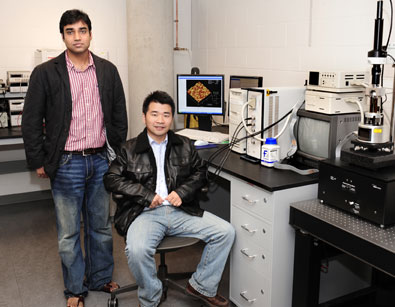Inside Iowa State
Inside ArchivesSubmit newsSend news for Inside to inside@iastate.edu, or call (515) 294-7065. See publication dates, deadlines. About InsideInside Iowa State, a newspaper for faculty and staff, is published by the Office of University Relations. |
Nov. 7, 2008 
ECpE assistant professors Santosh Pandey (left) and Liang Dong show off the department's new bioengineering lab. The atomic force microscope (far right) is the newest addition to the lab. Photo by Bob Elbert. New labs offer new opportunitiesby Dana Schmidt, Department of Electrical and Computer Engineering Since the first phase of the Electrical and Computer Engineering Building Addition opened last spring west of Coover Hall, researchers in the electrical and computer engineering department (ECpE) have witnessed firsthand the positive effect a new facility can have on research. Researchers in the emerging field of bioengineering, as well as professors in more traditional fields, are experiencing the impact. The building was completed as the department celebrates its centennial this year. New is good"Before the new building opened, we did not have a dedicated lab space for bioengineering," said Santosh Pandey, ECpE assistant professor. "We only had a shared space in the Carver High-Speed Communications Laboratory in the old Coover Hall, which primarily had electronic measurement equipment." Now Pandey and his bioengineering colleagues, including assistant professors Liang Dong, Sumit Chaudhary and Jaeyoun Kim, have the lab of their dreams. It's equipped with three high-powered microscopes (including a new atomic force microscope that can study nanoengineered materials and single molecules), furnace, high-precision electrical instruments, heater, chemical and biological safety hoods, distilled water tank, carbon dioxide incubator for growing biological specimens, and a centrifuger. Pandey finds the new equipment integral to successfully completing his current research project, understanding the behaviors of parasitic nematodes that destroy soybean crops. Pandey's team fabricates microscale fluidic devices for experiments to understand nematode behavior and the relation between its behavior and its genetic composition. Pandey said the U.S. Army and Department of Defense are interested in this research area. The ability to understand biological intelligence could be mimicked in devices such as search and navigation tools that use artificial intelligence. "Our new microscopic tools allow us to take real-time images and capture events at a very high resolution," Pandey said. 
Assistant professor Liang Dong works at a high-resolution, phase contrast microscope in the new bioengineering lab. Photo by Bob Elbert. Draw for graduate studentsDong, who arrived at Iowa State in 2007, said he had almost no research space when he started. He and his graduate students are enjoying the new lab. "Now we've brought in almost all the equipment we want," Dong said. "Our graduate students especially enjoy using the equipment." The new equipment allows Dong and his students to dig into three main research projects:
Because all of Dong's research is conducted on the micro- or nanoscale, the microscopes and other equipment provided in the new lab space are essential. It also could make his research more economical in the long run, saving him $1,000 to $2,000 per experiment to get the cell cultures he needs for his research. Efficiency in combining labsResearchers in the department's bioengineering area aren't the only ones benefiting from the new facilities. Professors in the Very Large Scale Integrated (VLSI) circuits, microwave and radio frequency (RF) areas also are seeing positive changes. Robert Weber, the David C. Nicholas Professor in Electrical and Computer Engineering, said the new lab space for RF, microwave and VLSI will enhance the research of such faculty as professors Randall Geiger and John Bowler, associate professors Degang Chen and Jiming Song, assistant professor Nathan Neihart, and senior lecturer Mani Mina. "The new space is larger and brings the equipment together in one place," Weber said. Before the new addition was built, the RF, microwave and VLSI labs were spread throughout the Durham Center and Coover Hall and many laboratories were operated separately, depending on the funding source or principal investigator. Now, all of the laboratories, including the Carver High-Speed Communications Laboratory, have been combined to better support research efforts of VLSI faculty. New directions for researchFaculty agree the new facilities will allow them to recruit better graduate students and faculty candidates, as well as provide a great space for collaboration and innovative, interdisciplinary research. The College of Engineering's new bioengineering minor will bring students who never would have considered electrical engineering careers into the bioengineering lab. Additionally, the new facility opens the door for Iowa State to compete with top universities that already have bioengineering programs. Perhaps the strongest evidence of the building's impact is when it motivates faculty to explore new, cutting-edge research avenues, as seen in Pandey's work. "Having the new facility and equipment has made me think of research avenues beyond conventional electrical engineering. I have found a new research direction that addresses key questions in the field of plant pathology. It's difficult, but it's interesting and futuristic," he said. |
Quote"Having the new facility and equipment has made me think of research avenues beyond conventional electrical engineering." Santosh Pandey |